PMD FLYMPH
Some time back, Tom Travis did a great article about PMD's, including a plethora of great patterns. One of those patterns was a well-dressed example of an early flymph pattern that I really liked. His version was dressed on a turned down eye hook with a couple turns of hackle wound behind the eye. I decided to tie a couple up using a later style of flymph, with the hackle palmered through the thorax on a turned up eye hook. I posted a picture of it on the bulletin board and stuffed them in my fly box.
Last fall at the Idaho Fish-In, Vickie and I were fishing our way back to Lowell from Missoula along the Lochsa River. We stopped at one very nice spot with trout rising everywhere. We picked spots to fish and proceeded to toss every dry fly we had in our fly boxes at those (insert expletive here) trout without so much as a look.
I had noticed at an earlier spot that there had been some PMD activity, but there were none at this spot. I decided to try my PMD flymph just in case. One the first cast I hooked up with a very nice cutthroat, also on the third cast and the fourth. Once again the trusty old timey flies worked their magic
Tom was nice enough to share his pattern with all of us; I thought I'd do the same.
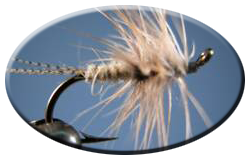
Materials:
- Hook: Mustad 94842, size 14
- Thread: Black or Gray (I used Danville 70 denier Gray)
- Hackle: Light Gray Dun Hen Hackle or Honey Dun Hen Hackle with an almost white center
- Thorax: Dark Gray Ostrich Herl (Tom used a Partridge Aftershaft Feather)
- Rib: Fine Copper or Gold wire
- Tail: Three or four fibers from a Lemon Wood Duck Flank feather
- Body: PMD colored dry fly dubbing of your choice. I prefer beaver or muskrat.
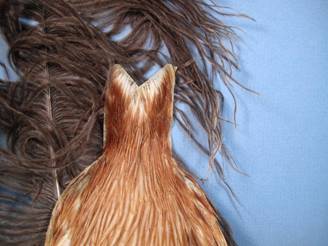
This is the Ostrich Herl and Honey Dun hen neck I used for this fly. I used the Honey Dun with almost white list or center after reading in one of Syl Nemes' books that he preferred this feather for PMD soft hackles.
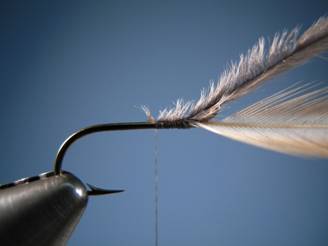 1. Pinch the barb on your hook if you prefer and secure it in the vise. Start your thread directly behind the hook eye with 3 to 4 turns. Trim excess thread. (Note: The barb is not pinched in this series for proportion references.)
1. Pinch the barb on your hook if you prefer and secure it in the vise. Start your thread directly behind the hook eye with 3 to 4 turns. Trim excess thread. (Note: The barb is not pinched in this series for proportion references.)
 2. Tie the hackle to the hook with the feather point extending over the hook eye and the glossy side down. Secure the stem with one or two turns and tie in the Ostrich Herl in the same manner. Wrap the thread toward the bend of the hook for 6 or 7 turns then trim off the excess stem of the hackle. The butt of the Ostrich Herl should have been covered completely. As a note, I strip a few extra barbs from the far side of the hackle feather. When I wrap the hackle this gives me a bare stem against the hook shank, plus, stripping away a few barbs gives a flat spot on the stem for easier wrapping.
2. Tie the hackle to the hook with the feather point extending over the hook eye and the glossy side down. Secure the stem with one or two turns and tie in the Ostrich Herl in the same manner. Wrap the thread toward the bend of the hook for 6 or 7 turns then trim off the excess stem of the hackle. The butt of the Ostrich Herl should have been covered completely. As a note, I strip a few extra barbs from the far side of the hackle feather. When I wrap the hackle this gives me a bare stem against the hook shank, plus, stripping away a few barbs gives a flat spot on the stem for easier wrapping.
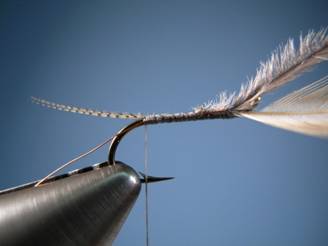 3. Tie in your choice of rib (I prefer the copper rib but you may do better with gold) and wrap the thread back in touching turns over the rib material to a point above the barb of the hook.
3. Tie in your choice of rib (I prefer the copper rib but you may do better with gold) and wrap the thread back in touching turns over the rib material to a point above the barb of the hook.
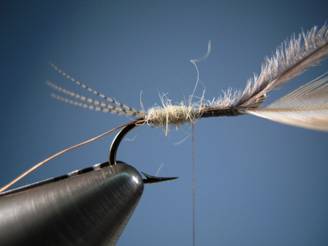 4. Measure the three or four fibers of lemon wood duck so the tail will be about the same length as the body and tie in with one or two wraps. Take a turn of thread under the tail fibers to set them at a slight upward angle, and then take a turn around the tie in point for the tail.
4. Measure the three or four fibers of lemon wood duck so the tail will be about the same length as the body and tie in with one or two wraps. Take a turn of thread under the tail fibers to set them at a slight upward angle, and then take a turn around the tie in point for the tail.
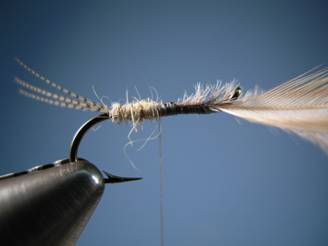 5. Dub a sparse body about two thirds of the way back toward the eye of the hook.
5. Dub a sparse body about two thirds of the way back toward the eye of the hook.
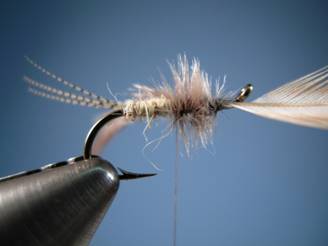 6. Bend the shaft of the Ostrich Herl 90 degrees and wrap the herl back to where the thread is hanging in touching or close turns. Secure the herl with one full turn of thread. Trim the excess feather.
6. Bend the shaft of the Ostrich Herl 90 degrees and wrap the herl back to where the thread is hanging in touching or close turns. Secure the herl with one full turn of thread. Trim the excess feather.
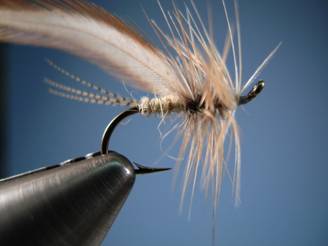 7. Bend the shaft of the hackle feather 90 degrees and make one or two touching wraps of hackle at the front of the thorax, then palmer the hackle back to the where the thread is hanging in open turns. Secure the hackle with two turns of thread. Trim off excess hackle by cutting or breaking.
7. Bend the shaft of the hackle feather 90 degrees and make one or two touching wraps of hackle at the front of the thorax, then palmer the hackle back to the where the thread is hanging in open turns. Secure the hackle with two turns of thread. Trim off excess hackle by cutting or breaking.
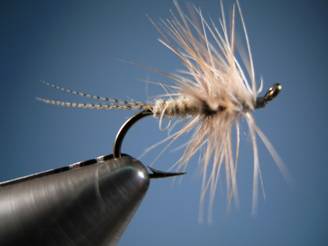 8. Wrap the tying thread forward through the hackle in widely spaced turns to a point just behind the hook eye. This reinforces the hackle stem and thorax. I hate a fly that's only good for one fish. Sweep the hackle back slightly with a hackle guard or fingers and whip finish the thread behind the eye. Trim excess thread, apply head cement and the fly is finished.
8. Wrap the tying thread forward through the hackle in widely spaced turns to a point just behind the hook eye. This reinforces the hackle stem and thorax. I hate a fly that's only good for one fish. Sweep the hackle back slightly with a hackle guard or fingers and whip finish the thread behind the eye. Trim excess thread, apply head cement and the fly is finished.
This fly is dressed on a light wire hook so it will fish just under or in the surface film if fishing slow water. It will be tossed about in the currents of fast water, often dragged to the depths. If the fly sinks deep, just before it reaches the lie your fishing to, lift the rod tip, causing the fly to rise in the water column. This rise will often trigger a strike from a trout. I usually start fishing the fly like a dry, casting upstream and across, mending as needed. As the fly drifts past my position I raise my rod tip and "high stick" the fly past my position, then continue to fish the fly as a wet fly on the swing. Once the fly has completed the swing and his hanging "on the dangle" I retrieve it with a couple of figure of eight strips then wait a few seconds. Only then do I pick up the fly and recast. Fishing this way covers a lot of water with each cast. The longer your fly is in the water, the better chance you have of catching a fish
For more great info, check out:
Beginning Fly Tying | Intermediate Fly Tying | Advanced Fly Tying.
